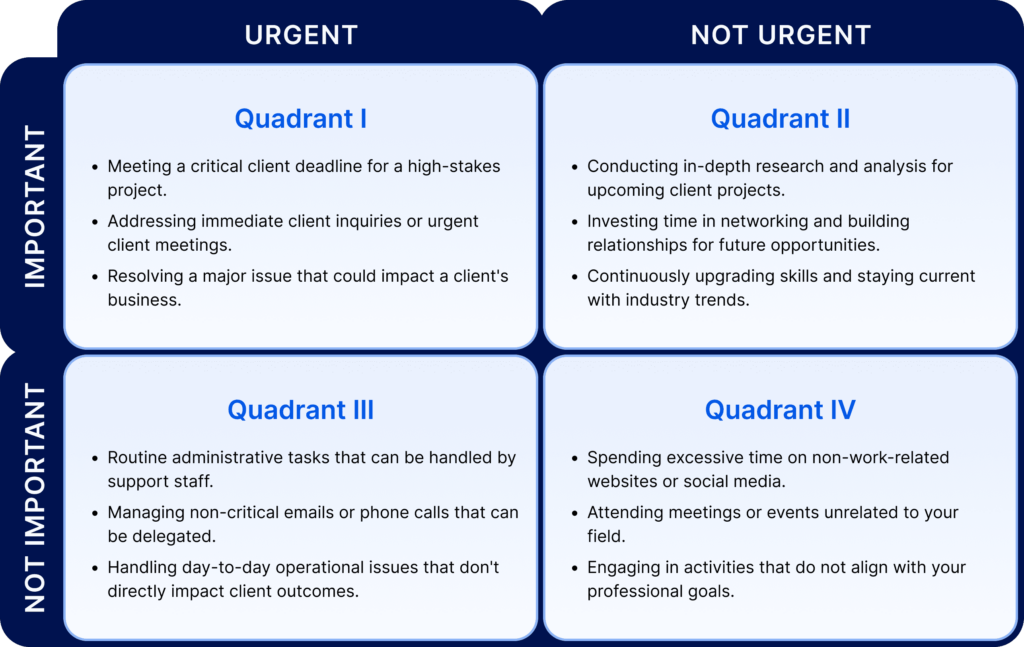Most of us are guilty of occasionally wasting valuable time. One of the reasons is that we are so busy that we can only focus on the most urgent things. The result is that often we forget the things that may be less urgent but are still important. This is where the time management matrix comes to the rescue.
Distinguishing between important and urgent is not easy. When we are overwhelmed with a full schedule and many pending tasks, the difference can become even more blurry. Even though both labels seem interchangeable, they are very different. Imagine a tool that can help you not only prioritize your to-do list but also revolutionize the way you approach your daily tasks. The time management matrix is a simple yet powerful framework to categorize and conquer your tasks. Let’s see how you can utilize it and regain control of your time and schedule!
What is the Time Management Matrix?
A time management matrix is a powerful tool for categorizing tasks based on their urgency and importance. It helps individuals and businesses to prioritize their activities effectively in order to maximize productivity and facilitate goal achievement. The matrix divides tasks into four quadrants based on importance and urgency.

Two people developed a time management matrix.
Dwight D. Eisenhower introduced it, believing that priority is related both to a task’s importance and its urgency. The higher the assigned priority, the more attention and time it merits.
Stephen Covey, the second key person, popularized and expanded Eisenhower’s matrix. He concluded that efficient management strategies are not about managing time itself. Rather, they are about how to focus attention and prioritize.
In Covey’s time management matrix, any task, activity, or responsibility occupies a section in a matrix with four quadrants. The criteria for assignment are:
- Urgency: What requires immediate attention;
- Importance: What has the highest significance or value.
Instead of tackling the urgent things first, awareness is raised about value and importance. By dividing tasks in this way, it should become obvious what tasks should be first.
What are the 4 categories of the time management matrix?
Each quadrant of Covey’s time management matrix is the result of a combination of urgent/not urgent and important/unimportant.
- Quadrant 1: Urgent and important
- Quadrant 2: Not urgent but important
- Quadrant 3: Urgent but not important
- Quadrant 4: Not urgent and not important
Let’s see an in-depth explanation of each quadrant!
Q1: Necessities
Quadrant 1 groups together activities and tasks that are critical and require immediate attention. It is clear that anything that falls into this category is very important and deserves the necessary time and focus. It’s in the name, after all: urgent and important.
Examples of activities that fall into this quadrant are prescheduled meetings with customers, improvements to implement, solving urgent problems, etc. Highly effective people should start with tasks in this quadrant.
Q2: Extraordinary productivity
Tasks in this quadrant are important but not urgent. The tendency with activities that fall in this category is to postpone them.
Ideally, these important tasks should have priority and you should give them primary focus. These are the strategic activities with the highest impact. Working on them will make your business stronger and will lead to personal growth and development.
An example of a quadrant 2 activity is project planning. That is something that is often postponed, but that is essential for sustainable growth.
Q3: Distractions
In Quadrant 3, you find activities that are urgent but unimportant in the long term. These are items that occupy your thoughts but primarily serve as distractions.
On top of that, people often consider them enjoyable or easy, which leads to them being given higher priority. Upon closer examination, you can likely remove many of these tasks from your work schedule.
While it may be impossible to eliminate all Quadrant 3 tasks, it’s essential to reduce their number as much as possible. One effective approach is to delegate them to others. Another solution is to group and complete many of these smaller tasks together.
Scheduling a dedicated hour for answering emails is a more efficient strategy than handling them individually throughout the day. Don’t allow yourself to be distracted by an “urgent” label in the subject line.
Q4: Waste
Q4 tasks are neither urgent nor important. Basically, these are time wasters.
The danger is spending too much time on them resulting in wasting precious time. Activities in this category should be reduced to a minimum.
How to create a time management matrix?
Creating your own time management matrix is easier than you think. We’ve developed a step-by-step guide to help you do it:
- Identify all your tasks and activities
You should make a comprehensive list of all the tasks, projects and activities you need to complete or are currently working on. These can be work-related tasks, but also personal commitments and other responsibilities.
- Determine the urgency and importance of each task
For each task or activity on your list, you should assess its urgency and importance. Categorize them based on urgency and importance.
- Create the time management matrix
Draw a 2×2 grid on a piece of paper or use digital tools like a spreadsheet or time management apps. Label the vertical axis as “Urgency” and the horizontal axis as “Importance”. You’ll get the four quadrants we’ve described above.
- Place each task in the quadrant it belongs to
We know it’s hard, but you should be as honest and objective in your evaluation as possible.
- Prioritize and get to work
Once you’ve categorized all your tasks into a time management matrix, it’s time to focus on the first quadrant (Urgent and Important) and leave enough time to work on Quadrant 2 as well.
What is the Difference Between “Important” and “Urgent”?
The term “important” relates to its contribution to continuing goals. Completing these tasks can be relevant to growth and continuation. These activities deserve priority and continuous attention.
They do not always need to be attended to immediately. However, by not prioritizing them, they could become urgent problems.
Urgent activities require immediate attention. As soon as they appear they demand immediate attention. Their importance is mainly at that very moment and they can detract from important activities and long-term goals.
Time Management Matrix: The Benefits
Using the Stephen Covey time management matrix can help you analyze your activities and priorities. When you analyze your work activities or even your private life, you often discover that most activities fall into the urgent categories (Q1 and Q3). Q2 (important but not urgent) is typically an underrepresented Covey quadrant.
This is where the power of this time matrix lies, and you should not underestimate the importance of Q2. The activities in this quadrant represent the strategic aspect of your business or personal life. Ignoring this quadrant could result in missing out on personal development and your ultimate goals. You must include this category in your balanced and efficient time management, making Q2 extremely important.
The application of the Covey time management matrix in the workplace specifically brings many benefits:
-
Increased productivity
This method assists in organizing and categorizing activities. Assigning a task to one of the four quadrants helps to decide whether it should be prioritized, scheduled, or even eliminated. It builds efficiency and focuses attention on what matters most. Creating a prioritized list helps to get more important things done.
-
Self-discipline
Self-discipline means consciously taking control of behavior. This type of restraint helps to replace negative actions with positive ones. It is the result of prioritizing, organizing, and avoiding distractions.
-
Clear habits
Categorizing activities can clarify certain patterns in behavior. It helps to assess someone’s behavior. Identification of patterns gives clues as to where to make changes, and which habits to develop, and to focus on what is important.
-
Learn to let go
Let go of distractions. Giving time-wasters (Quadrant 4) less priority, enables you to accomplish more, in both quantity and quality. The Covey matrix gives the framework and confidence to delegate responsibilities when necessary and when to say no to a new task.
-
Improve planning skills
Being able to prioritize tasks enables you to determine your immediate objectives and overall goals. When the priorities are set in this way, realistic time frames can be attached to these activities.
If you add these habits of highly effective people to your routine, you’re already doing better than most people out there.
How to Use Time Management Matrix to Boost Your Productivity
Identify your priorities

The whole idea behind the Covey time management matrix is to stimulate questioning as to whether a task is important or is only a priority because of its urgency.
The first step, therefore, is to identify this concept for all tasks. Assigning each task to one of the four quadrants is what helps the most. With this graphical aid, it is immediately evident where to place a task in the schedule.
Put it in writing
The result is the same whether it is written with pen and paper or using a digital tool. Chronicling helps to create a visual reminder and engages our thought processes. This documentation combined with the time matrix helps to make priorities clear. So keep the Covey matrix in a visible place, then it acts as a constant reminder.
Include deadlines
After clearly listing each task, assign deadlines, which will guide you in prioritizing tasks. With the dates in mind, some tasks may need to be pushed forward, while others can wait.
Do it regularly
How often you should perform this time management process depends on the application and circumstances. There are no strict rules regarding this. Some find that reviewing and updating once a week is sufficient.
In other situations, the workload and the nature of your activities may require a daily update. Regardless of the frequency you choose, the crucial point is to consistently allocate a specific time for this activity. This guarantees the continuity of your tasks and activities.
One-week assessments
A different way of using the matrix is by making a weekly assessment. This requires six blank matrices, one for each workday, and one for the weekend.
At the end of each day, all activities of that day are arranged in the matrix, including the time spent on them. At the end of the week, all activities are summarized in one matrix.
This will create awareness of what kind of activities make up a week; if they are urgent and/or important.
Time Management Matrix Examples for Service Businesses
Quadrant 1 – Urgent and Important (Do Now)
- Meeting a critical client deadline for a high-stakes project.
- Addressing immediate client inquiries or urgent client meetings.
- Resolving a major issue that could impact a client’s business.
Quadrant 2 – Not Urgent but Important (Plan and Focus)
- Developing a comprehensive and customized strategy for a client.
- Conducting in-depth research and analysis for upcoming client projects.
- Investing time in networking and building relationships for future opportunities.
- Continuously upgrading skills and staying current with industry trends.
Quadrant 3 – Urgent but Not Important (Delegate or Minimize)
- Routine administrative tasks that can be handled by support staff.
- Managing non-critical emails or phone calls that can be delegated.
- Handling day-to-day operational issues that don’t directly impact client outcomes.
- Participating in meetings that do not contribute significantly to client projects.
Quadrant 4 – Neither Urgent nor Important (Avoid or Limit)
- Spending excessive time on non-work-related websites or social media.
- Attending meetings or events unrelated to your field.
- Engaging in activities that do not align with your professional goals.
- Pursuing low-priority tasks that don’t add value to your clients or your business.
Remember that the goal of using a time management matrix is to prioritize tasks effectively and achieve your professional services KPIs. Focus on Quadrant 2 as much as possible to proactively work on tasks that drive the growth and success of your service business. Delegate or minimize tasks in Quadrant 3, and avoid or limit tasks in Quadrant 4 to maximize your productivity and efficiency.
Combine the Time Management Matrix with a Powerful Scheduling App
If you want to claim back your time and get the most out of it without wasting time on repetitive and boring tasks, let us introduce you to your digital partner – Trafft. It basically takes care of your whole Quadrant 3 in time management matrix, allowing you to focus on Quadrant 2 and supercharge your growth.
Trafft can help with that as well, as it provides you with high-converting booking pages, employee and client management, and insightful business metrics, and it does all that with a perfectly user-friendly platform. Powerful integrations with the most popular tools allow you to automate more than bookings, but rather most of your business.
Trafft also offers you comprehensive features to create employee schedules and an insightful business dashboard you can use to improve your business and marketing efforts. Payment processing integrations allow you to always get paid on time, whether after the appointment or in advance. There is no room for no-shows and double bookings, as this booking platform leaves no room for errors.
What are some other advanced features Trafft offers?
- Multiple location support
- Multi-language support
- Recurring appointments
- Group bookings
- Easy rescheduling
- Reminders
- Booking form and booking page templates
- Extras for extra boost in revenue
- Customer notes to improve customer experience
Trafft’s extremely feature-rich, allowing you to run your business and grow your brand with ease. You won’t break the bank either, as Trafft’s plans are tailored to fit the needs and budgets of all service businesses. They also offer an unparalleled free plan with superior features that you can’t find anywhere else. Don’t believe us? Experience Trafft for free, and upgrade later at any time!
FAQs About the Time Management Matrix
1. What is the time management matrix, and how does it work?
The time management matrix is a tool that aids in work prioritization according to priority and urgency. In his book “The 7 Habits of Highly Effective People,” Stephen Covey presented it. The matrix is divided into four quadrants, each representing a distinct type of task.
2. Who developed the time management matrix, and what is its purpose?
American author and leadership expert Stephen Covey created the time management matrix. By classifying jobs according to their level of urgency and importance, it aims to assist people in time management. Covey thought that by employing this framework, people might concentrate on what is genuinely important and avoid getting sidetracked by unimportant chores.
3. How can the time management matrix help me improve my productivity and efficiency?
The time management matrix offers a clear structure for prioritizing tasks, which can increase productivity and efficiency. People can do more in less time by concentrating on crucial, high-value tasks. Also, people can eliminate or delegate low-value chores to avoid distractions and free up time for more crucial duties.
4. What are the four quadrants of the time management matrix, and how do they differ?
The time management matrix’s four quadrants are as follows:
Quadrant 1: Critical and pressing duties.
Quadrant 2: Significant but not urgent jobs.
Quadrant 3: Tasks that are urgent but not crucial.
Quadrant 4: Tasks that are not urgent or crucial.
5. What types of tasks should I focus on in each quadrant of the time management matrix?
People should concentrate on finishing jobs that are both significant and urgent in quadrant 1, such as those that involve deadlines, emergencies, or crises. People should concentrate on vital but non-urgent tasks in quadrant 2, like long-term planning, personal growth, and connection building. Quadrant 3 duties should be reduced or assigned to others since they are urgent but unimportant. Tasks in Quadrant 4 should be avoided since they are neither urgent nor vital.
6. How can I use the time management matrix to prioritize my daily tasks and activities?
People should first list all of their chores and group them into one of the four quadrants before prioritizing them using the time management matrix. After that, they should order jobs in Quadrant 1 before moving on to Quadrant 2. As much as practicable, quadrants 3 and 4 should be reduced or removed.
7. How do I determine which tasks belong in each quadrant of the time management matrix?
People should first list all of their chores and group them into one of the four quadrants before prioritizing them using the time management matrix. After that, they should order jobs in Quadrant 1 before moving on to Quadrant 2. As much as practicable, quadrants 3 and 4 should be reduced or removed.
8. How do I know if I’m spending too much time in one quadrant of the time management matrix?
An imbalance may be indicated by spending an excessive amount of time in one quadrant of the time management matrix. For instance, if someone spends too much time in quadrant 1, they might continually be responding to emergencies rather than putting enough effort into long-term planning. Similarly, if an individual is spending too much time in quadrant 4, they may be avoiding crucial chores and procrastinating.
9. Can the time management matrix be used in personal as well as professional settings?
An imbalance may be indicated by spending an excessive amount of time in one quadrant of the time management matrix. For instance, if someone spends too much time in quadrant 1, they might continually be responding to emergencies rather than putting enough effort into long-term planning. Similarly, if an individual is spending too much time in quadrant 4, they may be avoiding crucial chores and procrastinating.
10. Are there any limitations or drawbacks to using the time management matrix?
The time management matrix has the drawback of not taking individual characteristics or context into consideration. Something that is essential and significant to one person could not be to another. Also, it may be challenging to prioritize some jobs because they may fit into numerous quadrants. Finally, the time management matrix ignores outside variables that may have an impact on a person’s capacity to properly manage their time, such as interruptions or unforeseen events.
11. On the time management matrix, which quadrant is the most optimal?
On the time management matrix, Quadrant 2 is often considered the most optimal quadrant. This quadrant represents tasks that are “Not Urgent but Important.” This quadrant gives you strategic focus, a proactive approach, less stress, and high-impact activities that drive business growth.
More Resources for Time Management Matrix
Learning how to use the Covey time management matrix takes time, but it brings many rewards. The more time you invest in using Covey’s Matrix, the more aware you become of which quadrant holds the majority of your workload.
Effective time management isn’t about simply checking off as many activities as quickly as possible. It’s better to accomplish fewer tasks and give each one the attention it deserves.
This way of thinking assists you in understanding what holds significance and what is of lesser importance. In addition to identifying the most important tasks, you can utilize scheduling apps and other electronic time management tools to aid in organization. With effective time management, you can accomplish the most.
Productivity necessitates hard work and effective organization. Initially, the changes may appear minor but continue to review your activities and remain honest with yourself. How much time do you dedicate to important tasks? Plan for the upcoming week and explore the adjustments you can implement. As long as you take positive steps, the outcome will be increased productivity and success.
If you enjoyed reading this article about the time management matrix, you should read about why time management is important.
We also wrote about a few related subjects like time management systems, time management courses, time management quotes, using a time management coach, time management strategies, techniques, and time management statistics.
Do you want an app for that? We also selected the best time management apps, but also free time management apps for tight budgets, and if you’re looking for a time tracking app, we picked the best of them.
Needless to say, we are really into time management and we don’t like to waste time because we know how poor time management can affect us.



